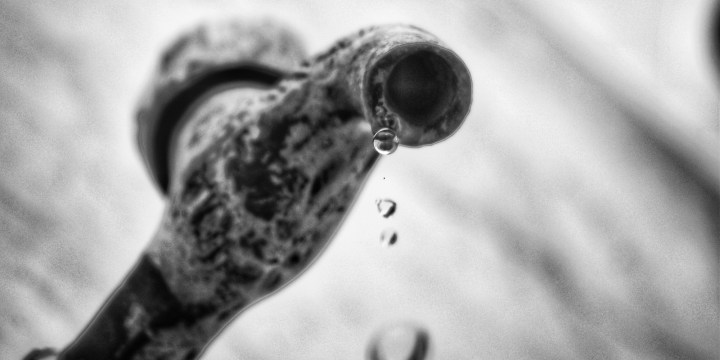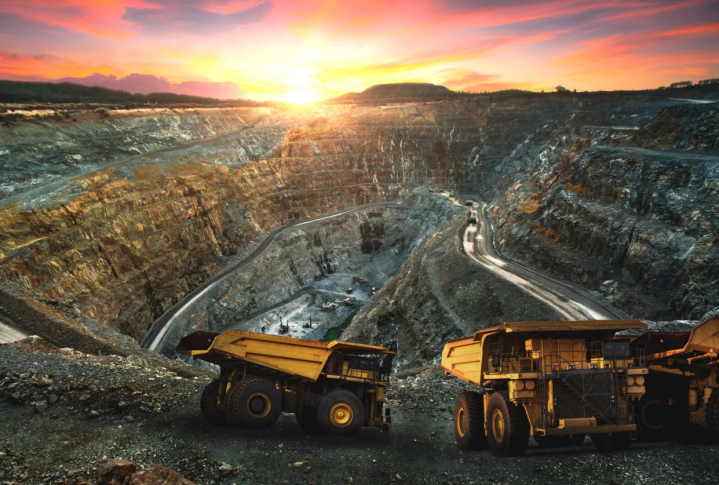WATER SECURITY
Urgent steps need to be taken if Gauteng is to avoid running out of water soon

‘The rich combination of weak governance and climate change will extract a high price’. This warning comes from climate experts as Joburg, Tshwane and Ekurhuleni impose water restrictions while battling to keep the taps from running dry.
‘For me, the main question is, why was Rand Water apparently caught out by this event?” said Francois Engelbrecht, professor of climatology and director of the Global Change Institute at Wits University.
Parts of Gauteng are battling with Level 2 water restrictions that initially kicked in due to power failures at Rand Water’s waste water treatment plant in Vereeniging, which had a knock-on effect on water systems and reservoirs.
Met with a spike in demand due to the Highveld heatwave and rolling blackouts from Eskom, water authorities are pleading with residents to cut back so they can replenish the reservoirs.
But these restrictions point to poor planning and infrastructure problems. Climate experts say Rand Water should have been better prepared, as there is sufficient water — the Vaal Dam is at 92% capacity — and the heatwave in Gauteng was predicted before the water restrictions were put in place.
South Africa is in a La Niña cycle, which means a wetter climate, and scientists warn that we are fast approaching the El Niño cycle, which is dry, so the government needs to act fast or Day Zero might be unavoidable.
Where it started
Rand Water said in a statement on 30 September that “on Thursday 29 September 2022 at 10h40, Rand Water’s Zuikerbosch Water Treatment Works (ZBWTW) experienced a power failure at one of the engine rooms which supplies water to the Eikenhof and Mapleton Booster Pump Stations.
“The cause of the trip at the engine room 4 is being investigated by the technical teams from both Eskom and Rand Water.
“This incident has resulted in a loss in pumping of 600MId to Eikenhof and 630MI/d to Mapleton. Electricity supply was later restored and as a result water supply resumed at 13h22.”
The managing director of Johannesburg Water, Ntshavheni Mukwevho, told Our Burning Planet that from 23 to 30 September there had been four power failures at ZBWTW — their bulk water supplier plant — which consequently affected the plant’s ability to pump at full capacity, with a knock-on effect on the reservoirs in the system.
Since then, Rand Water has said rolling blackouts and the recent hot weather — increasing the demand for water — “has severely affected capacity at various Johannesburg Water systems (residents and towers).”
Johannesburg Water’s technical officials explained that the initial power failures at Rand Water’s Zuikerbosch Water Treatment Works affected distribution to Johannesburg Water’s Commando Road system, and meant they weren’t able to deliver the required volume of water in the reservoir systems.
Read more in Daily Maverick: “Fully restoring water to Johannesburg ‘could take longer than a week’ ”
Johannesburg Water announced on 11 October that “the Commando system’s recovery was derailed due to Eskom reinstating load shedding and high demand in the total Rand Water’s supply areas”.
As a result, Joburg Water had to close the Brixton reservoir to build capacity, and in the interim, water was provided to affected areas through stationary water tanks and mobile tankers.
The latest from Johannesburg Water is that their “infrastructure (reservoirs and towers) are strained, with minimal recovery and improvements in a few systems”.
Joburg Water said it would invest R340-million over the next three years, “to expand the Commando system’s scope and infrastructure to ensure continuous water supply to the residents of the City of Johannesburg”.
Visit Daily Maverick’s home page for more news, analysis and investigations
The City of Tshwane and City of Ekurhuleni have also had water cuts, with Rand Water announcing the implementation of Level 2 water restrictions on 3 October.
Some areas such as Soshanguve, parts of Akasia and The Hills in Pretoria East had water supply interruptions or shortages.
Rand Water said the restrictions were the result of a sharp increase in water consumption, resulting in a decline of their overall reservoir storage capacity (from 52% to 38%). The purpose of the restrictions is to ensure that overall reservoir storage capacity is restored to 60%.
When asked why water facilities were not exempt from scheduled electricity blackouts, as it threatens the basic human right of access to water, Joburg Water spokesperson Nondumiso Mabuza told Our Burning Planet, “We are not exempt from load shedding and Eskom reinstated load shedding affecting Rand Water and in turn Johannesburg Water.”
Asked if they had applied for exemption, Mabuza said, “Yes, City Power did look into it but due to how the power system is designed, it would not be possible to isolate our reservoirs and towers.”
Eskom spokesperson Sikonathi Mantshantsha told Our Burning Planet that the implementation of load shedding was governed by Nersa regulations that stipulate what facilities may be exempted.
“Those are the coal mines that supply Eskom and help in the production of electricity, and the seat of government, as well as the Parliament building,” said Mantshantsha.
“Load shedding is only implemented as a last resort due to a shortage of generation capacity.”
Rand Water should have been prepared
The City of Tshwane and City of Joburg have been continually pleading with residents to make efforts to reduce their water consumption and water usage to avoid reservoirs running dry.
Rand Water has communicated that the “demand on existing water supplies by ever-growing populations is of concern”, and that the heat wave has spiked demand, saying in a statement on 6 October, “We know it is hot, but please use water sparingly to allow reservoirs to recover. Saving water is critical, and you are an important part of the solution!”
#waterconservation #RandWater #WaterWise #reduceconsumption
The increasing demand made on existing water supplies by ever-growing populations is of concern. We are in this together – saving water is a team effort and requires all of us to do our part! Don’t use more than you need pic.twitter.com/24WFbcmr3j— Rand Water (@Rand_Water) October 10, 2022
But if there hadn’t been the original power failures and operational failures, and there were adequate facilities to deal with the expanded population, would there be these issues?
Climate expert Engelbrecht said, “Every summer has a few heatwaves, and they do not generally result in this type of water scarcity in Gauteng. Especially because the level of the Vaal Dam is still well above 90%.”
Engelbrecht said heat waves were a normal part of climate variability and while climate change caused by humans was making events like heat waves more frequent and intense, “it’s nothing new. Rand Water should have been prepared”.
Our Burning Planet asked Rand Water for comment, but it had not replied at the time of publication.
The climate is on our side — for now
Willem Landman, a professor of meteorology at the University of Pretoria and a specialist in seasonal to decadal forecasts, explained that even though the Highveld was experiencing a heat wave, the rest of the summer would actually be cooler because of the La Niña cycle, which meant a wetter rainy season.
Read more in Daily Maverick: “Why is there a heat wave in parts of SA when it’s not yet summer?”
Dr Pedro Monteiro, Chief Scientist at the Council for Scientific and Industrial Research, pointed out that this was also an important reason why we might miss Day Zero this year.
El Niño and La Niña are part of climate variability — naturally occurring changes in the climate that take place in a three to five-year cycle.
Monteiro and Landman explained that we’ve been in an extended La Niña cycle, with this coming summer being the third La Niña in a row. Engelbrecht says this is “quite exceptional” as it’s only the third time this has happened since 1950 — and it means we’re due for a swapping of the cycle.
During La Niña, Monteiro explained, there is more rising air, particularly around the land areas of southern Africa, and with more rain and more clouds, it will be cooler.
“The latest seasonal predictions for South Africa is that this summer is yet again going to be a summer of above-normal rainfall across our summer rainfall regions, including the important mega dams in the east,” said Engelbrecht.
“So that really just makes what has happened even less understandable.”
Beware El Niño
If we are having water issues in the La Niña period, when we have water supply, it points to management issues in the system and doesn’t bode well for when we enter the dry period in El Niño.
With El Niño, Monteiro explained, there is more of a high pressure system, and the descending hot air causes a lack of clouds, with less precipitation.
Monteiro said that during Cape Town’s drought in 2017, “the weakness in strategic water governance was identified as a key factor behind the Day Zero near-miss. Cape Town was woefully unprepared for a likely dry cycle and probably started to respond a year too late.
“The water (and beyond) governance situation in Johannesburg is Cape Town on steroids.”
We are in a water crisis, but our water supply is plentiful, being in the “wet” La Niña period, so as we approach the dry cycle of El Niño in the next few years, the operational capability of our water systems does not look like it will be able to cope.
“There is actually very limited time for the city to put the governance systems in place to be able to cope with two or three years of very reduced rainfall,” said Monteiro.
High price of weak governance and climate change
“We’ve learned from Cape Town just how important it is to get the strategy and the operational side working together… as a way of mitigating the impacts of decreased water supply.”
Monteiro said “the rich combination of weak governance and climate change will extract a high price”.
Engelbrecht agreed with Monteiro, saying that “the real test for Gauteng in terms of its water security is going to come during the next El Niño phase”.
Explaining that the last El Niño cycle in 2015-2016 saw the biggest drought on record over the central regions of SA, with the Vaal Dam dropping to critically low levels of about 25%.
Engelbrecht explained that below 20% risks Day Zero because if the dams supplying the Vaal Dam are low, it’s very difficult, for engineering reasons, to get large amounts of water pumped uphill all the way to Johannesburg.
Due to anthropogenic climate change (caused by humans), the naturally occurring cycles of El Niño and La Niña will intensify.
“The big risk is in a changing world, in a warmer world, is that the El Niño periods [and resulting droughts] will become longer lasting and more intense,” said Engelbrecht.
“And that means the likelihood of a Gauteng Day Zero event becomes larger and larger for as long as the world continues to warm.”
So as we head into the next El Niño period, where we could have three to four years of drought — with the Vaal Dam reaching critical levels — Engelbrecht says “we are going to need Rand Water to be as efficient as it possibly can be in terms of managing this resource.
“And of course we all need to help them to save water and to use water sparingly. It’s good to have that culture and to practice that even now, as we prepare for the risk of a Gauteng Day Zero event.” DM/OBP





















Why blame Rand Water? The problem is eskom! And if you’re looking to blame someone for the inevitable Gauteng day Zero, look no further than nomvula mokonyane’s meddling in phase 2 of the Lesotho Highlands project (to ensure the anc could loot as much as possible)